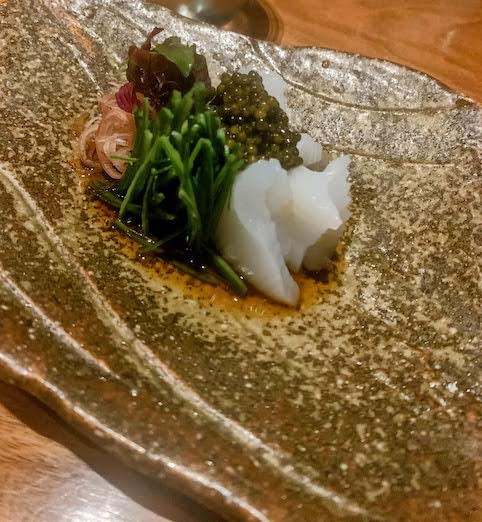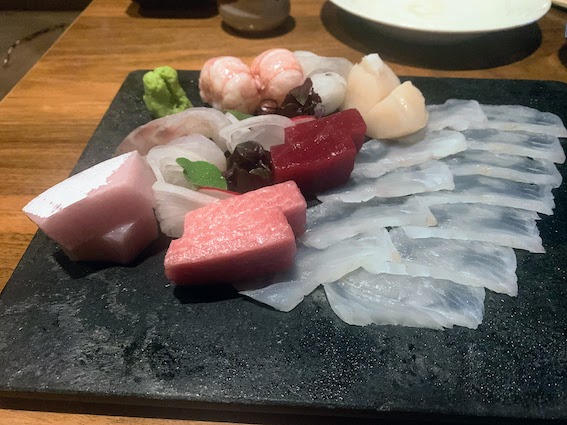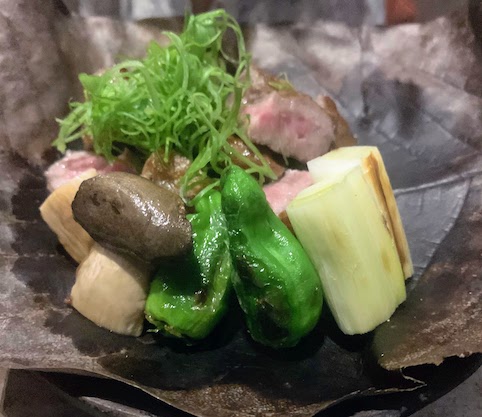Chef all the way from Japan, seafood mostly from Cornwall. UMU offers a food experience that exceeds expectations.
You’ve probably heard that UMU is not easy to find. Twenty years old this September, and in the same ‘street’ in Mayfair as the Guinea Grill, it has minimal external signage, just the legally obligatory menu.
Press the illuminated panel and the door slides open like the doors to the bridge of USS Enterprise, although presumably not with the assistance of two burly stage hands.
We enter from full evening sunshine and can’t see a thing until our eyes adjust to the low key lighting. This is not Instagram friendly, but at these prices you’d need to be a rich ‘gramma anyway. This is a restaurant where people with taste dine discreetly.
A lot of wood, a lot of calm, stylish, design. The wait staff wear black and move around silently and efficiently. It has had a Michelin star since 2005 and you don’t achieve that by being sloppy.

UMU features the cuisine of the region of Kyoto cuisine (Kyo-ryori), Kyoto was once the capital of Japan, and a city on the island of Honshu. So obviously seafood is a feature of the menu. Special is the Kaiseki menu, a feature of the region. We are eating a la carte tonight with fish impeccably sourced from around the UK.
After an amuse we have Cornish cuttlefish, raw of course, treated in the Ike jime method (look it up but brace yourself first) with myoga which is a crunchy, zesty, Japanese kind of ginger, and dressed with Tosazu, a Tosa-stvle vinegar seasoned with kombu seaweed, bonito fish flakes, amazake and mirin.
Remarkable dancing flavours and the cuttlefish is like biting into the smoothest hunk of butter. The upgrade of caviar on top is the cherry on the ‘cake’ and we chase every last expensive egg off the plate, using a finger tip because there are some things chopsticks can’t handle.
As the stage is cleared, the next performer comes on, a clear soup, with what appears to be a flower floating in it, but which is in fact thinly sliced sea bass and courgette fashioned into petals. A yuzu element adds a citric touch. Superb fish, delicate stock and a texture contrast in the courgette.

Executive Chef Ryo Kamatsu’s special selection of sashimi is glorious, you have to take a moment to drink it all in. Each slice of fish is precisely cut, all is fresh enough to swim off. Interestingly sashimi turbot is included, a good local fish, as well as two grades of tuna, some crayfish, scallops and some very good whitefish, possibly seabass. A dab of soy, a tickle of wasabi is all that’s needed.
Some like it hot, and Tempura can be scalding, but here it is crunchy and fresh without being a safety hazard. Good tempura has hardly any batter on it, we’re not talking about the local chippy here, the contents mustn’t be swamped. This is especially true when the fish concerned is Wild Cornish lobster, a truly precious delicacy. We love these, although one tempura seems to have lost its contents.
Throughout our waiter, Portuguese, but of course Portugal has been highly influential in Japan, has smoothly explained what we are eating and gently conveyed chef’s recommendations on how to eat it. That may sound like we were being patronised, but we weren’t. The recommendations enhanced the experience a lot. This is also what you pay for.

And you pay a fair bit for Grade 11 Wagyu hoba-yaki in miso nut sauce. Huba-yaki is a dish prepared by grilling miso and other ingredients on a leaf of the Japanese Magnolia, To do this the dish comes to the table with a spirit lamp underneath it. Here the other ingredients are nuts and Wagyu beef.
If you have never eaten top quality wagyu it has quite a strong beefy taste, a bit of umami, distinct sweetness, and a certain nuttiness. It’s extremely soft, as the fat has a lower melting point than regular beef, so it stays ‘buttery’. It’s an experience to really savour.
The nuts in the miso were a good contrast, but as we savoured very slowly the spirit lamp made the miso mix extremely hot, it was soon too hot to handle. I think we should perhaps have blown out the lamp after it arrived.
A bit blown out ourselves by now, we eschewed the offer of sushi and went for dessert, Manjari chocolate fondant, buckwheat ice cream. Manjari is made from rare cocoa beans from Madagascar and is quite sharp, almost citrus, which makes the chocolate refreshing. Buckwheat ice cream is made by steeping roasted buckwheat in milk then straining the milk off and proceeding as usual, sometimes mixing some of the kernels into the mixture before freezing.

It’s a slightly unusual flavour but we like it. There is an extensive selection of premium sake curated by Head Sommelier Ryan Johnson, but tonight we have a Japanese white wine, as the wife doesn’t like sake, a remarkably good wine it is too.
Umu’s longevity is not hard to explain. Extremely high quality Japanese cuisine served to a discerning, and wealthy, clientele. A place for a treat or a special occasion.
Address: 14-16 Bruton Pl, London W1J 6LX
Website: www.umurestaurant.com
Social Media: @umurestaurant
